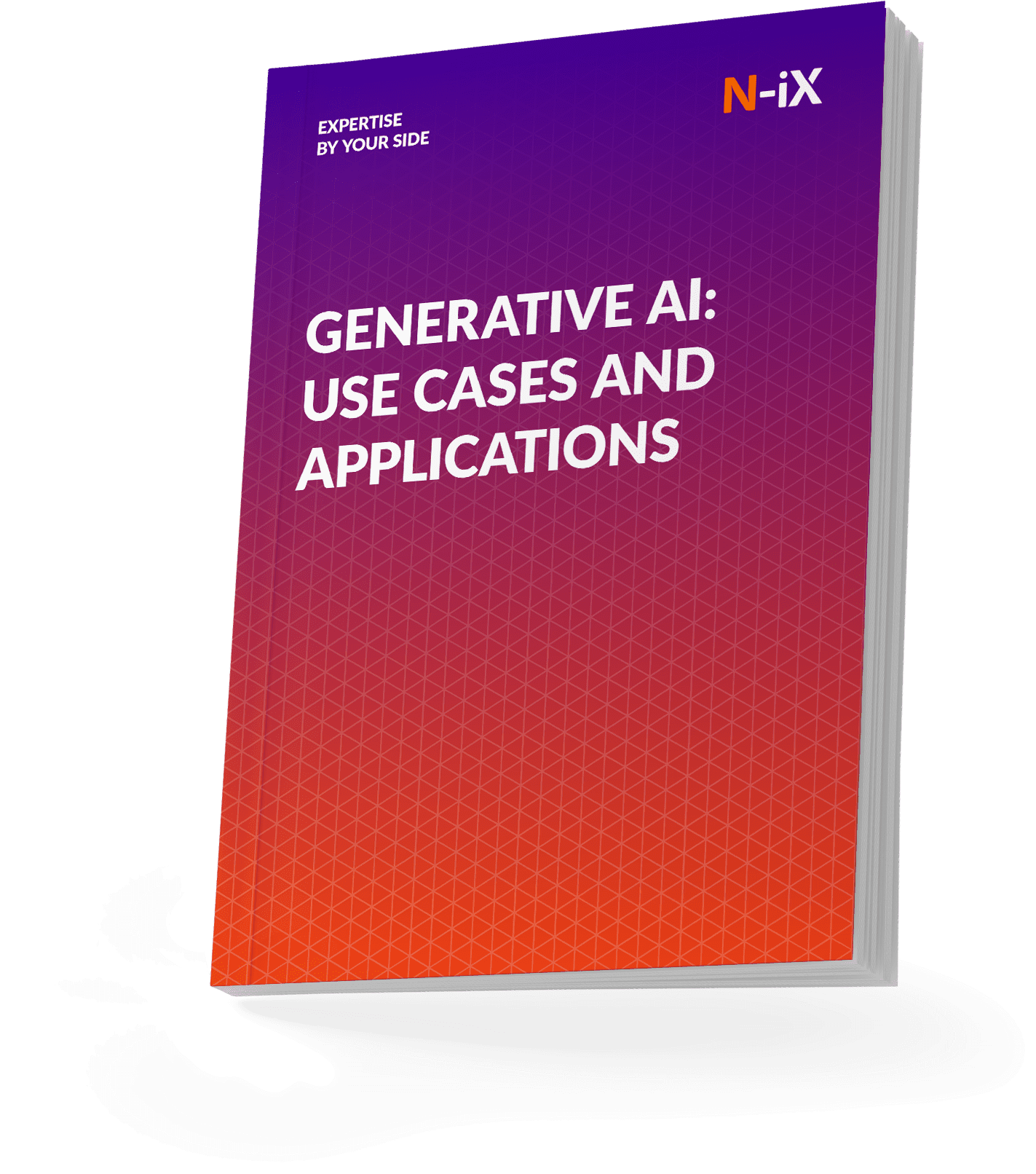Conversational AI transforms how banks interact with and deliver customer value. Chatbots and voice assistants are becoming common access points in banking – handling everything from balance checks to mortgage applications. According to Gartner, conversational AI technologies can reduce labor costs by $80B in 2026.
The emerging technology holds tremendous potential to make banking more streamlined and customized. Notably, conversational AI in banking enables the round-the-clock availability of banking support. 24/7 virtual assistants resolve common issues quickly so customers avoid waiting on hold or navigating phone menus. Intelligent bots also apply data analytics to give personalized financial recommendations – alerting customers to relevant new products or savings opportunities based on spending patterns and account activity.
As we delve into AI in banking, following our insights into areas like AI, ML, and Data Science, we're set to explore the diverse applications of conversational AI in this sector. This exploration will encompass these AI systems' scope, underlying technologies, myriad benefits, and challenges in the banking industry.
Conversational AI in banking: Use cases
Financial organizations and banks deploy conversational AI across front and back-office operations to automate processes and improve customer experience. Conversational AI in banking can automate enormous volumes of repetitive tasks. Banking chatbots can reduce operational costs by handling thousands of routine queries, secure payments, loan applications, and data verification processes. It frees bank personnel to have higher-value discussions with customers about complex needs – wealth management, small business lending, home financing, and more.
Below are some of the major use cases and applications emerging:
1. Personal banking assistants
AI-powered chatbots and voice assistants have become increasingly common. These digital assistants are adept at handling basic queries from customers. For instance, they can provide account balances, display recent transaction histories, explain various charges, and manage debit card controls. Customers can interact with these bots in natural language, asking questions like "What was my last purchase?" or giving commands such as locking their debit card.
Moreover, these bots are not limited to merely providing information; they can execute banking commands like funds transfers or bill payments by integrating directly with core banking systems. This integration allows them to debit accounts for transactions, offering a more comprehensive service. Biometric authentication methods add an extra layer of security, giving customers the confidence to conduct transactions through the bot.
Personal banking assistants also play a crucial role in offering personalized financial advice. By analyzing account activity, they can provide tailored suggestions. For instance, if they notice high expenditure on credit cards, they recommend transferring balances to cards with lower APRs or opening savings accounts to build emergency funds.
2. Customer service agents
Conversational AI is revolutionizing customer service in banks by automating tier-1 support. These bots efficiently handle routine inquiries such as account statements, check or deposit processing times, certificate of deposit renewal rates, loan repayment schedules, and more. Addressing these basic questions reduces call volumes, freeing up human agents to tackle more complex issues.
These AI-driven assistants enhance issue resolution speed as well. They can instantly access customer data and transaction histories, providing detailed information like finalized debit amounts or reference numbers without consulting back-office systems. Furthermore, they can connect customers with the appropriate specialists for more specific inquiries or issues.
3. Mortgage assistance
Conversational AI is also making strides in the home lending process. Mortgage bots are designed to streamline the mortgage application process through automation. They guide applicants through the necessary documentation, asking customized questions based on previous responses to assist in collecting such information as tax returns and bank statements.
These bots keep borrowers consistently informed about the status of their applications and the subsequent steps, significantly enhancing the customer experience. They notify all relevant stakeholders as the loan progresses through various stages, like underwriting approval or handover to the closing team. By automating the collection and routing of information, AI-driven mortgage assistants expedite the loan origination process, making it more efficient and user-friendly.

Read more: 5 conversational AI use cases that are reshaping industries
Conversational AI in banking: Implementation challenges
While conversational AI promises tremendous benefits, effectively deploying the technology poses some core challenges for banking institutions. Yet, there is a range of implementation challenges that are prominent and should be carefully assessed beforehand. According to the Deloitte 2024 banking and capital markets outlook, banks will likely struggle to customize products and services due to legacy systems and the inability to curate tailored experiences using customer data.
Thus, banks must carefully validate conversational AI applications to mitigate emerging risks around data governance, responsible AI, and system accuracy. Below are some of the most pressing implementation barriers to overcome:
Integrating with legacy banking systems
One central obstacle banks face when rolling out conversational AI is integrating the technology with existing infrastructure. Core banking systems maintaining customer accounts and transactions rely on older, on-premise software. Connecting bots with legacy architectures while ensuring security and data integrity poses difficulties.
Banking organizations must invest heavily in API development and cloud infrastructure to enable read-and-write access between AI applications and source systems. Ongoing governance is also critical – access credentials, permissions, and data flows need continuous monitoring. Lacking proper integration foundations hampers bot potential and risks stability issues.
Ensuring data security and privacy
Advanced security protections are paramount when enabling AI access to confidential customer information. Banks must implement robust data encryption, access controls, activity logging, and cybersecurity oversight beyond usual measures.
Internal dialog logs from bot interactions also create massive stores of personal customer data. Storage using enterprise-grade databases alongside data masking, tokenization, and strict access policies is essential to preventing exposure. Strict vetting of any third-party bot providers is also crucial to safeguard privacy.
Managing the risk of bias in AI systems
In advanced functions like personalized recommendations for new products, conversational AI must make independent decisions based on customer data. However, bias can emerge in algorithmic systems – disadvantaging specific demographics.
Banks are ethically obligated to proactively monitor, evaluate, and mitigate any discriminatory-based risk across both systems. It involves thorough audits for factors of skew neutrality – from the training data to the machine learning models. Achieving fair and transparent AI output requires continual bias testing and adjustment.
Generative AI, according to the same Deloitte report, has advanced to the point where it can produce "deepfakes," posing a significant challenge for financial institutions in distinguishing between actual human customers and digital representations mimicking them. This rapidly evolving risk landscape is becoming a substantial barrier to preserving customer trust.
Achieving high levels of accuracy
The technology must consistently deliver accurate, reliable information and outcomes for customers to trust and regularly engage with conversational AI. Insufficient training data, limited understanding of banking topics, or inability to address complex questions hampers performance.
To minimize errors, banks must annotate massive datasets – augmenting logs of past customer interactions with human feedback on appropriate responses. Expanding knowledge resources so bots can clarify unfamiliar concepts is equally crucial. High accuracy builds user confidence and maximizes automation rates over time.

Navigating the challenges of implementing conversational AI in banking requires a partner with expertise and a deep understanding of the industry's nuances. N-iX stands out as an ideal provider for these solutions, adeptly handling integration with legacy systems, ensuring top-notch data security and privacy, and managing bias in AI systems.
Our approach to maintaining high accuracy in AI interactions builds user trust and enhances efficiency. With N-iX's comprehensive expertise in conversational AI, banks can overcome implementation hurdles and leverage AI to transform customer experiences and operational processes.
The future of conversational AI in banking
Conversational AI marks a profound shift in banking – underpinning everything from retail banking assistants to mortgage origination and customer support services. Seamless integration with core back-end infrastructure ensures bots have secure access to necessary systems and data flows. With a thoughtful design focused on accuracy, transparency, and ethical AI practices, financial organizations can transform customer experience through smart automation while reducing costs.
Early movers who best leverage conversational AI have a distinct competitive edge. They deliver the comprehensive, personalized services customers increasingly expect – at greater convenience. Adoption is still in the early phases, though – most banks are conducting limited pilots. Over the next 3-5 years, conversational AI assistants will proliferate across banking channels as reliability and business cases improve. Thus, conversational interfaces will ultimately emerge as a primary method for everyday customers to access financial services.
Keep reading: How AI in fintech takes the industry forward
Final remarks
Partnering with experienced technology solutions providers like N-iX is crucial for organizations navigating this transformative landscape. With a deep understanding of conversational AI's latest trends and technologies, N-iX offers the expertise and innovation necessary to design and implement effective AI solutions.
Whether you're looking to enhance customer interaction, streamline operations, or secure transactions, N-iX’s seasoned professionals can guide you through every step, ensuring that your bank remains at the forefront of this digital revolution. Contact N-iX to explore how conversational AI can elevate your banking services and give you a distinct edge in today's competitive financial marketplace.
EBOOK
Get your ultimate guide on Generative AI use cases and applications


Success!

Have a question?
Speak to an expert




